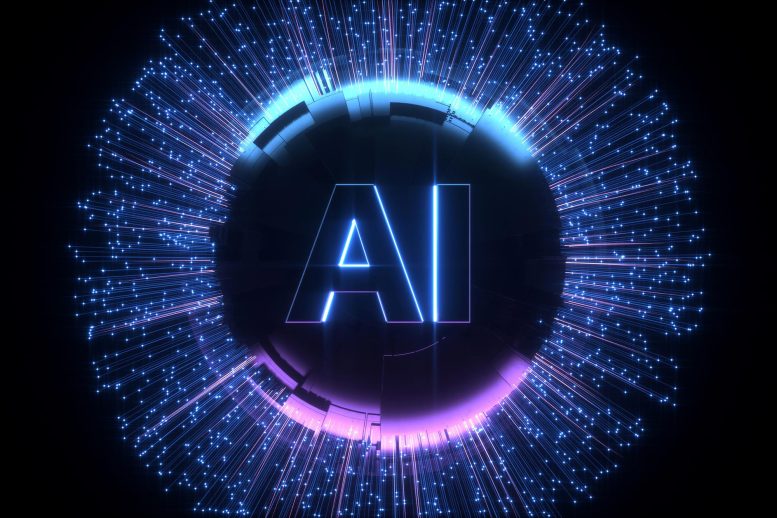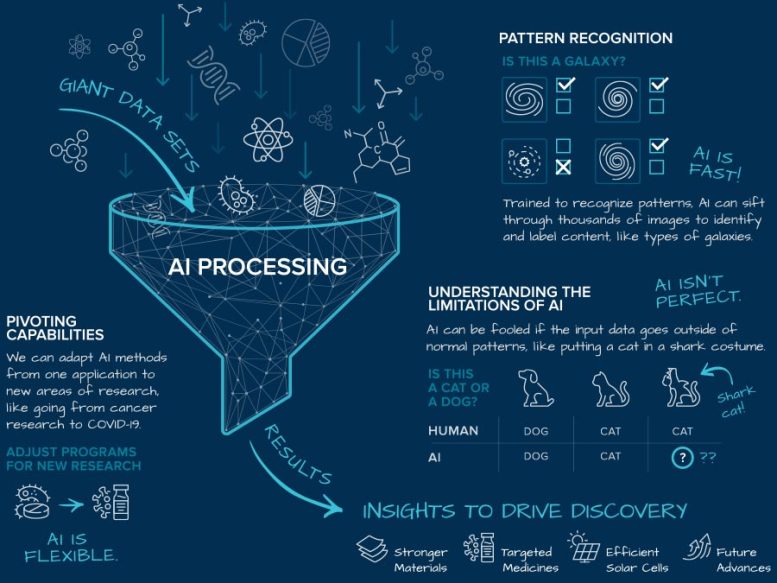
Artificial intelligence, particularly through machine learning, is revolutionizing how we solve complex problems in various fields including science, medicine, and technology. Facilities like Argonne National Laboratory are leading these advancements, using AI to predict complex system behaviors, improve material selection, and assist in global challenges like disease and climate change.
What Is Artificial Intelligence?
Artificial intelligence (AI) is the collective term for computer technologies and techniques that help solve complex problems by imitating the brain’s ability to learn.
AI helps computers recognize patterns hidden within a lot of information, solve problems, and adjust to changes in processes as they happen, much faster than humans can.
In this Science 101: What is Artificial Intelligence video, Argonne National Laboratory scientists Taylor Childers and Bethany Lusch discuss AI — the computer technologies and techniques that help solve complex problems by imitating the brain’s ability to learn. Researchers use AI to be better and faster at tackling the most difficult problems in science, medicine, and technology, and help drive discovery in those areas. This could range from helping us understand how COVID-19 attacks the human body to finding ways to manage traffic jams.
Researchers use AI to be better and faster at tackling the most difficult problems in science, medicine, and technology, and help drive discovery in those areas. This could range from helping us understand how COVID-19 attacks the human body to finding ways to manage traffic jams.
Many Department of Energy (DOE) facilities, like Argonne National Laboratory, assist in developing some the most advanced AI technologies available. Today, they are used in areas of study ranging from chemistry to environmental and manufacturing sciences to medicine and the universe.
AI is used to help make models of complex systems, like engines or weather, and predict what might happen if certain parts of those systems changed — for example, if a different fuel was used or temperatures increased steadily.
But there are many more uses for AI.
A key tool in Argonne’s AI toolbox is a type of technique called machine learning that gets smarter or more accurate as it gets more data to learn from. Machine learning is really helpful in identifying specific objects hidden within a bigger, more crowded picture.
In a popular example, a machine learning model was trained to recognize the main features of cats and dogs by showing it many images. Later, the model was able to identify cats and dogs from pictures of mixed animals.
Similar machine learning models can help scientists identify, for example, one type of galaxy from another when they receive object-packed images from space telescopes.
Machine learning is just one of many AI techniques that help us learn more quickly and accurately. They can help choose the right molecule or chemical for a new material and may one day guide new experiments on their own.
Argonne has worked with many organizations around the world to become a leader in artificial intelligence use and development, this includes applying AI to:
- Improve battery life for cars and energy.
- Build better climate models that can predict wildfires, hurricanes, and other disasters, and help our communities and power companies protect against them.
- Find those parts of viruses that attack our cells and develop drugs to fight them.
What is Artificial Intelligence?
Analyzing large complex data to perform human tasks at computer speeds.
Artificial intelligence (AI) is now a part of our daily lives, helping to simplify basic tasks, such as voice recognition, content recommendations or photo searches based on people or objects they contain. Scientists are using AI in similar ways to advance our understanding of the world around us. It can help them analyze mountains of data faster, and has provided better solutions. Different AI techniques are used in many research areas, from materials science and medicine to climate change and the cosmos.
For example, we can train AI to recognize complex patterns by viewing many different examples. Researchers can use this capability to find new and improved materials for things like solar cells or medicine by training AI on all the known materials for that application. Then AI can help researchers zero in on other promising materials that can be fabricated and tested in a laboratory.










I certainly hope AI wrote this article.